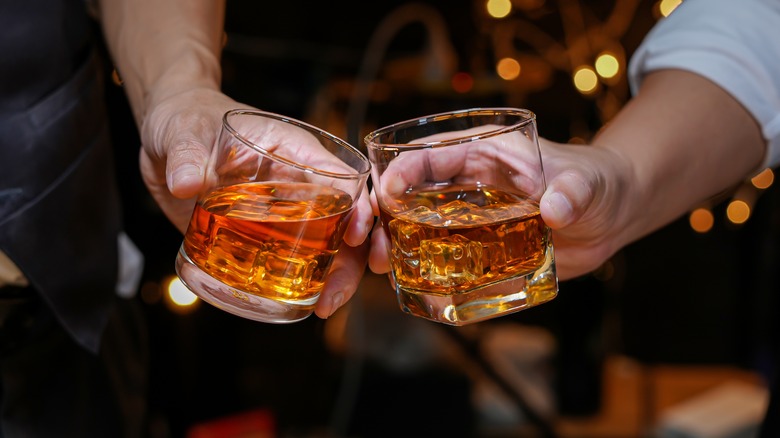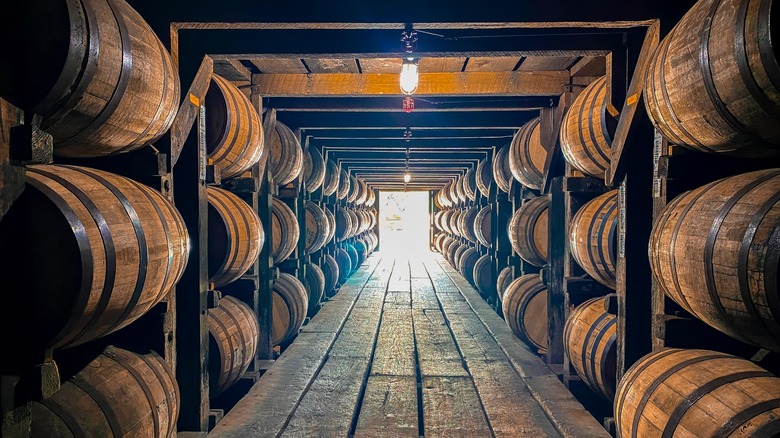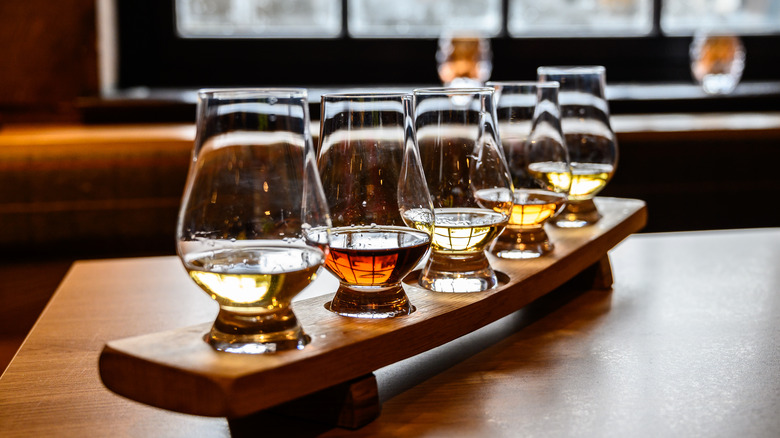Is There A Difference Between Whiskey And Bourbon?
The distinction between whiskey and bourbon can be a bit blurry — isn't bourbon just a type of whiskey, after all? While this is true, bourbon uses unique ingredients, production processes, and is made in a specific place, making it distinct from the broader category of whiskey.
Whiskey refers to spirits distilled from a fermented grain mash, with rye, barley, wheat, and corn being common players. The resulting clear alcohol is then aged in wooden barrels to impart a brown color and rich flavor. Many subcategories exist within the whiskey label, and bourbon is the bestselling whiskey style in the United States — which makes sense, as it can only be produced in that country to earn the name.
Contrary to popular belief, bourbon doesn't need to be made in a specific region of the United States, though Kentucky is most famous for its bourbon. The grain mash this spirit is distilled from must be made up of at least 51% corn. The alcohol must then be aged in new, charred American oak barrels. Despite these rigid requirements, there's room for variation. Other grains are often mixed into the corn-heavy mash to create diverse flavor profiles. High-rye bourbon is typically spicier, and wheated bourbons are smoother and sweeter. There's a wide world to explore, and if you want to buy bourbon like a pro, it's good to have a handle on the basics.
The history of whiskey (and whisky)
Irish whiskey, Scotch whisky, Canadian whisky, and Japanese whisky are all popular styles you might find on liquor store shelves. And no, those last three are not a letter short. There is indeed a vast difference between whiskey and whisky, and all comes down to country. Whiskeys made in Ireland and the U.S. have the "e," but Canada, Scotland, and Japan drop it when referring to their own aged, grain-mash spirits.
The history of whiskey (or whisky!) and bourbon are obviously intertwined. It's believed that the earliest whiskey was distilled in Ireland or Scotland during the 11th to 12th century. In the 1600s, the young country of the United States was quickly becoming home to many European settlers, some of whom brought their distilling knowledge and unique tastes with them. Whiskey-making in the U.S. was an at-home "cottage industry" run by civilians for the most part, as the burgeoning colonies were not yet equipped for commercial production.
Eventually, immigrants from Scotland and Ireland put their Old World whiskey-making techniques into practice with grains that were available in the new one. Corn is native to the U.S., and early corn-heavy iterations of traditional whiskey" would come to be known as bourbon.
How Kentucky kicked bourbon into a boom
While barley had been the favored grain for Scottish whiskey distillers in their homeland, it didn't take well to the climate of the New World. Rye, imported by German transplants, was a popular substitute for distillers in northern territories. But as colonists moved south and further away from the East Coast, they found that corn was the most prevalent grain in the area. It was easy to grow in the land that later would become the state of Kentucky.
The first commercial bourbon distillery was established in Louisville, Kentucky by Evan Williams in 1783. Just two years later, the area was deemed "Bourbon County," and the spirits shipped from there were referred to as "whiskey from Bourbon." The liquor quickly became popular, as it was more widely available than the previously-favored rum, which suffered from a decline in triangular trade between Europe, Africa, and the Americas. By the mid-1800s, mass bourbon production was in full swing.
As with many alcohols, Prohibition laws dealt a big blow to bourbon. From 1919 to 1933, it was illegal to sell alcohol in the United States. After the repeal of many of these laws, bourbon production picked up the pace, but was slow to fully recover. It wasn't until 1964 that Congress passed a resolution declaring bourbon a distinctly American product, cementing its proud place in the country's cuisine. Today, bourbon is made throughout the U.S., with new distilleries opening every year.



